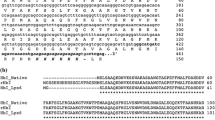Abstract
The features of random chemical modification are defined with reference to acetylation of bovine hemoglobin, which has been performed in a random manner so that all of the amino groups that participate in functional chloride binding (i.e., those that are oxygen-linked) could be identified. Random chemical modification, which has objectives different from those of both specific (selective) and extensive chemical modification, has been achieved for bovine hemoglobin with the mild reagent,14C-methyl acetate phosphate; retention of function was demonstrated by a Hill coefficient ofn=2.2 for the modified hemoglobin. After removal of unmodified Hb chains, the mixture of randomly modified acetylated α or β chains was subjected to tandem treatment with trypsin and chymotrypsin. Peptides were purified by HPLC and identified by amino acid analysis. The amount of radioactivity in the acetylated amino group of a purified peptide was taken as an estimate of the degree of chloride binding. For bovine Hb, two amino groups of the α-chain (Val-1 and Lys-99) and three amino groups of the β-chain (Met-1, Lys-81, and Lys-103) were shown to be oxygen-linked (i.e., to have incorporated significantly more radioactivity in the deoxy conformation compared to the same site in the oxy conformation). Three of these sites were already known chloride-binding sites [i.e., Val-1(α), the N-terminus of the α-chain, and two sites between the 2 β-chains of bovine hemoglobin, Met-1(β) and Lys-81(β); these findings support the conclusions of the random modification approach. Two other chloride-binding sites, Lys-99(α) and Lys-103(β), align the sides of the central dyad axis connecting the two well-known major chloride-binding sites of bovine Hb. The interrelationship of these five chloride-binding sites was assessed by improved molecular graphics. When viewed through the central dyad axis, the functional chloride-binding sites in the central cavity appear to be symmetrically related and to connect the two major chloride-binding sites. Modifiers or mutants that are directed at these regions in the central dyad axis may favor the deoxy conformation to provide a lower oxygen affinity by preventing the constriction of the central cavity that normally occurs upon oxygenation.
Similar content being viewed by others
References
Abraham, D. J., Wireko, F. C., and Randad, R. S. (1992).Biochemistry 31 9141–9149.
Antonini, E., and Brunori, M. (1970).Ann. Rev. Biochem. 39 977–1042.
Arnone, A. (1972).Nature 237 146–149.
Benesch, R., Benesch, R. E., and Yu, C. I. (1968).Proc. Natl. Acad. Sci. USA 59 526.
Bonaventura, J., Bonaventura, C., Sullivan, B., Ferruzzi, G., McCurdy, P. R., Fox, J., and Moo-Pen, W. F. (1976).J. Biol. Chem. 251 7563.
Bucci, E., and Fronticelli, C. (1985).Biochemistry 24 371–376.
Bunn, H. F. (1971).Science 172 1049–1050.
Chatterjee, R., Welty, E. V., Walder, R. Y., Pruitt, S. L., Rogers, P. H., Arnone, A., and Walder, J. A. (1986).J. Biol. Chem. 261 9929–9937.
Chiancone, E., Norne, J. E., Forsen, S., Antonini, E., and Wyman, J. (1972).J. Mol. Biol. 70 675–688.
Fantl, W. J., Di Donato, A., Manning, J. M., Rogers, P. H., and Arnone, A. (1987).J. Biol. Chem. 262 12,700–12,713.
Fermi, G. (1975).J. Mol. Biol. 97 237–256.
Garner, M. H., Bogardt, R. A., and Gurd, F. R. N. (1963).J. Biol. Chem. 250 4398–4404.
Imai, K. (1979).J. Mol. Biol. 133 233–247.
Kilmartin, J. V., and Rossi-Bernardi, L. (1969).Nature 222 1243.
Lalezari, I., Lalezari, P., Poyart, C., Marden, M., Kister, J., Bohn, B., Fermi, G., and Perutz, M. F. (1990).Biochemistry 29 1515–1523.
Manning, J. M. (1981).Methods Enzymol. 76 159–167.
Marden, M. C., Bohn, K. B., and Poyart, C. (1988).Biochemistry 27 1659–1664.
Martin de Llano, J. J., Schneewind, O., Stetler, G., and Manning, J. M. (1993).Proc. Natl. Acad. Sci. 90 918–922.
Moore, S. and Stein, W. H. (1973)Science 180 458.
Nigen, A. M., and Gurd, F. R. N. (1973).J. Biol. Chem. 248 3708–3715.
Nigen, A. M., Bass, B. D., and Manning, J. M. (1976).J. Biol. Chem. 251 7638–7643.
Nigen, A. M., Manning, J. M., and Alben, J. O. (1980).J. Biol. Chem. 255 5525.
O'Donnell, S., Mandaro, R., Schuster, T. M., and Arnone, A. (1979).J. Biol. Chem. 254 12,204.
Perutz, M. F. (1970).Nature 228 726–739.
Perutz, M. F. (1990). InMechanisms of Cooperativity and Allosteric Regulation in Proteins, Cambridge University Press, Cambridge.
Perutz, M. F., Kilmartin, J. V., Nishikura, K., Fogg, J. H., Butler, P. J. G., and Rollema, H. S. (1980).J. Mol. Biol. 138 649–670.
Qin, W., Smith, J. B., and Smith, D. L. (1992).J. Biol. Chem. 267 26,128–26,133.
Riggs, A. (1988).Ann. Rev. Physiol. 50 181.
Rollema, H. S., DeBruin, S. H., Janssen, L. H. M., and Van Os, G. A. J. (1975).J. Biol. Chem. 250 1333.
Stark, G. R., Stein, W. H., and Moore, S. (1960).J. Biol. Chem. 235 3177–3181.
Ueno, H., Pospischil, M. A., and Manning, J. M. (1989).J. Biol. Chem. 264 12,344–12,351.
Ueno, H., Pospischil, M. A., Manning, J. M., and Kluger, R. (1986).Arch. Biochem. Biophys. 244 795–800.
Ueno, H., and Manning, J. M. (1992).J. Prot. Chem. 11 177–185.
Vandegriff, K. D., Medina, F., Marini, M. A., and Winslow, R. M. (1989).J. Biol. Chem. 264 17,824–17,833.
Wagenbach, M., O'Rourke, K., Vitez, L., Wieczorek, A., Hoffman, S., Durfee, S., Tedesco, J., and Stetler, G. (1991).Biol Technology 9 57–61.
Wireko, F. C., Kellogg, G. E., and Abraham, D. J. (1991).J. Med. Chem. 34 758–767.
Author information
Authors and Affiliations
Rights and permissions
About this article
Cite this article
Ueno, H., Popowicz, A.M. & Manning, J.M. Random chemical modification of the oxygen-linked chloride-binding sites of hemoglobin: Those in the central dyad axis may influence the transition between deoxy- and oxy-hemoglobin. J Protein Chem 12, 561–570 (1993). https://doi.org/10.1007/BF01025120
Received:
Published:
Issue Date:
DOI: https://doi.org/10.1007/BF01025120




